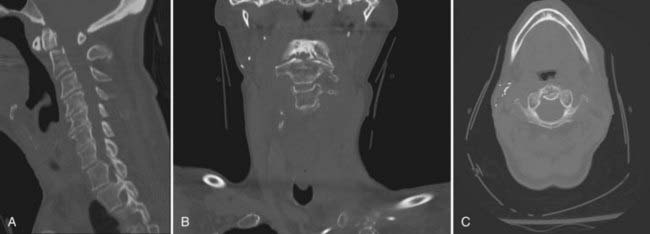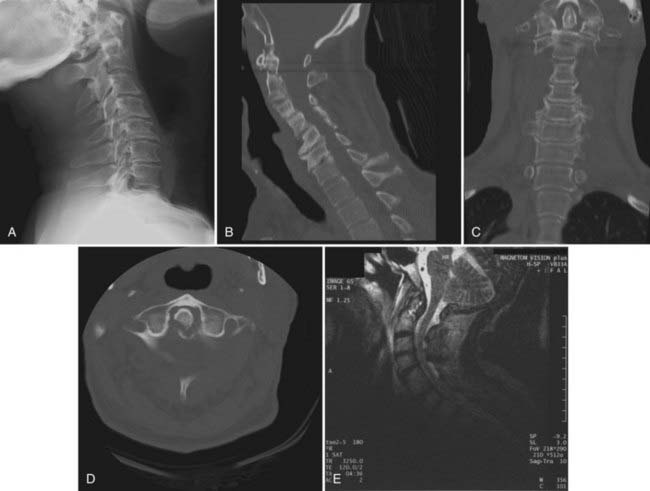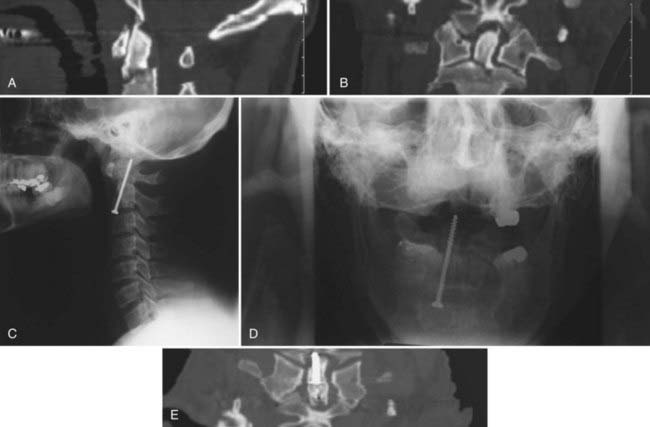CHAPTER 315 Evaluation and Treatment of Odontoid and Hangman’s Fractures
The estimated annual incidence of spinal cord injury in the United States, not including those who die at the scene, is approximately 12,000 new cases each year.1 The cervical spine is affected in more than 60% of spinal injuries.2 Cervical spine injury occurs in 1.5% of injured children,3 and 53% of these injuries are related to motor vehicles: motor vehicle crashes, 31%; pedestrian versus motor vehicle, 16%; and bicycle versus motor vehicle, 6%.4 The mortality rate for these injuries ranges from 25% to 50%.4,5 In the elderly, falls are the most common cause of cervical spine injury. Since 2000, the incidence of persons older than 60 years at time of injury has increased to 11.5%, as opposed to 4.7% before 1980.1
Approximately 9% to 20% of all cervical fractures are dens fractures,2,6–10 with most (65% to 74%) being type II fractures.2,9,10 C2 fractures are classified as odontoid fractures involving the dens; Hangman’s fractures, a traumatic spondylolisthesis through the pars interarticularis; and miscellaneous fractures, including facet fractures or injury through the foramen transversarium. These injuries may be missed clinically because of the lack of clinical signs except for neck pain. Os odontoideum and fractured calcified pannus may mimic acute C2 fractures.
Anatomy
The anatomy of the axis is unique in that it forms a connection with the mobile upper cervical spine and cranium and the lower cervical spine. This anatomy consists of the axis, atlas, odontoid process, occipital condyles, C2-3 disk, C1-2 facet joints, synovium of the occipital condyles, and the ligaments that attach to C1, C2, and the skull.11 Because the weight of the cranium is transmitted from a relatively lateral and posterior position to a medial and anterior position at C2, the axis is referred to as a transitional vertebra. The atlantoaxial complex is configured to allow much more rotational movement than in any other segment. Approximately 50% of the rotational movement of the entire spine takes place at C1-2; fusion of this segment would cause this motion to be lost. The atlantoaxial joints also allow about 50 degrees of axial rotation and 10 degrees of flexion-extension.
Other noteworthy features of the C1-2 joint include the absence of a true intervertebral disk and relatively loose capsular ligaments,12 evolution of the ligamentum flavum into a weaker atlantoaxial membrane, a rich blood supply from branches of the vertebral and carotid arteries, and an increased spinal canal diameter.13 The odontoid process is held tightly to the anterior portion of the C1 ring by the strong transverse ligament, which prevents subluxation in the sagittal plane. There is also close apposition of the spinal cord to the axis of rotation, which minimizes the torsional forces on the spinal cord that would be present if the cord were located more posteriorly. All these adaptations combine to make a highly mobile yet stable connection between the skull and the spine.
Odontoid Fractures
The treatment of odontoid fractures has long been a topic of debate. They are the most common and potentially most devastating of all axis fractures. Many classification schemes for odontoid fractures have been proposed, but the most commonly used is that described by Anderson and D’Alonzo in 1974.9 This scheme classifies odontoid fractures by anatomic location. Type I fractures involve an avulsion fracture of the tip of the odontoid and are thought to occur as a result of rotation and lateral flexion, which causes injury to the alar ligaments. Type II fractures are the most common and potentially the most dangerous and occur as a transverse fracture across the base of the odontoid process, just superior to the body of the axis. About 15% of these patients will have neurological injury; these fractures are unstable and require some type of immobilization. In 1988, a new subtype of odontoid fracture (type IIA) was described that involves comminution at the base of the dens.14 Type III fractures traverse the body of the axis. These fractures usually heal with nonoperative treatment (Fig. 315-1).
Type I Fractures
Type I fractures are rare and traditionally have been thought to be stable and thus managed nonoperatively.15 The mechanism of the injury is considered to be avulsion of one of the alar ligaments.16 The fracture plane is often cephalad to the transverse ligament and therefore does not cause a violation of ligamentous continuity. Several recent reports have noted that this avulsion may lead to atlanto-occipital dislocation and may therefore be unstable (see also Chapter 313).6,17 A thorough examination of this subject is difficult because of the paucity of cases in the literature; analysis of previous reviews indicates that type I fractures account for 0.82% of all odontoid fractures.18 Thin-cut computed tomography (CT) scans with sagittal and coronal reconstruction are the optimal method for radiologic evaluation; magnetic resonance imaging (MRI) or flexion-extension radiographs may be useful if instability is an issue.19 There are reports of ossiculum terminale being mistaken for a type I fracture.20,21 This entity is a congenital nonunion of the tip of the dens held in place by a firm segment of cartilage.
Type II Fractures
Type II fractures, which occur at the base of the dens, are by far the most common odontoid fractures seen in clinical practice.22 They are generally believed to be unstable; however, controversy exists regarding optimal management of these injuries.19,23 Many articles in the past have documented nonsurgical treatment by external immobilization, with reported nonunion rates ranging from 10% to 88%.2,24–27 There has been much debate whether internal fixation, either by odontoid screw or posterior screw fixation, should be the primary treatment modality or should be reserved for patients who fail external immobilization. Several reports have also described fracture mimicry attributable to os odontoideum28 or fractures of calcified pannus formation. These imposters must be actively searched for because they may result in inappropriate intervention. In addition, one must be sensitive to the loss of structural properties in the aged population secondary to osteoporosis or osteomalacia, which can make fractures difficult to identify (Fig. 315-2). Recently published literature has also brought attention to the increasing number of reported fractures associated with ankylosing spondylitis, disseminated idiopathic hypertrophic arthropathy, and end-stage degenerative spondylosis,29,30 all of which can lead to functional cervical ankylosis over time and an increased risk for fractures with even minor trauma. A refined evaluation protocol for at-risk patients using reformatted CT scans has decreased the likelihood of missed injuries and assists in treatment decisions.

FIGURE 315-2 A-C, Reformatted computed tomography (CT) scans showing a type II dens fracture missed on plain radiographs.
Nonsurgical Management of Type II Fractures
Nonsurgical treatment of type II odontoid fractures consists of either rigid collar fixation or halo immobilization. Halo-vest treatment has been shown to limit upper cervical motion by 75% versus 45% with a collar.31 The drawbacks with halo immobilization are many, including economic, social, pin site infections, skin breakdown, skull perforation, and overall nonunion on the order of about 32%.2,6,24,26,32–40
Several studies have attempted to characterize the risk factors involved in nonunion of type II fractures. Platzer and colleagues found that 75 of 90 patients returned to their preinjury activity level and were satisfied with halo–thoracic vest treatment. Successful fracture healing was achieved in 84% of patients undergoing this treatment. Cases in which nonunion was demonstrable on radiographs or CT scans within 6 to 12 months after trauma were attributed to increased age or greater dens displacement.24
Seybold and Bayley found a 65% overall fusion rate with halo immobilization and no significant difference in outcome in patients older than 60 years, in patients younger than 60 years, or by degree of displacement.41 Greene and colleagues reviewed 340 acute axis fractures and identified two categories of unstable type II fractures, which they recommended be treated by early surgical fusion. The first involves dens displacement of 6 mm or greater, and the second involves comminution of the dens.42 Hadley and coworkers found a 67% nonunion rate in patients with 6-mm or greater subluxation as opposed to a 9% nonunion rate in those with lesser degrees of displacement. They failed to find any correlation between a patient’s age or direction of subluxation.43–45 Dunn and Seljeskog found an increased risk for nonunion with conservative management in patients older than 65 years and in those with posteriorly displaced odontoid fragments. They reported a nonunion rate of 70% with retrolisthesis versus 30% with anterolisthesis.46
Because of these risk factors for nonunion (age >65 years, >6-mm displacement, posterior displacement), surgical management evolved as an appropriate treatment modality. Indications for surgery include irreducible or unstable fracture for which reduction is impossible; significant neurological deficit; previous nonunion; prolonged delay in treatment; injuries that preclude halo placement, including skull fractures and chest or facial injuries; and patients at high risk for nonunion, including the elderly and debilitated.47–49
Surgical management of these injuries can be approached either anteriorly or posteriorly. Posterior approaches involve the use of wire or cable, clamps, or direct screw fixation.50 These techniques involve C1-2 fusion and loss of motion at this joint. Loss of rotary motion at C1-2 is usually in the 50% range.51,52 Anterior procedures involve direct screw fixation across the fracture line. Traynelis and associates performed an evidence-based review of posterior bone and wire fixation of odontoid fractures and noted an overall success rate of 64%, with the morbidity and mortality rate approaching 2%.53,54 A variety of bone and wire fusion techniques have been described, including the Gallie (midline graft with a single wire), Brooks (bilateral sublaminar wires), and Sonntag (interspinous) methods. These techniques create a posterior tension band. Although successful, these techniques are not strong in extension and axial rotation. To overcome these deficiencies, Magerl described the technique of transarticular C1-2 fixation.76–78 This method involves screw fixation through the lateral joints of C1-2. Extensive preoperative planning is required to determine the course of the vertebral arteries because they may be injured by the trajectory of the screw. Harms and Melcher recently described a construct consisting of direct lateral mass screw fixation of C1 and pars or pedicle screw fixation of C2.58 This technique has proved to be biomechanically sound and technically easier than transarticular fixation, does not require the use of midline bone grafts, and can be performed despite C1 laminectomy.
Because of the potential morbidity and loss of motion with posterior C1-2 fusion, the use of anterior screw fixation for type II odontoid fractures has become increasingly popular. This technique provides immediate stabilization; we have performed this procedure and often discharged the patient the next day. The first reports of odontoid fixation were reported by Nakanishi in 198059 and Bohler in 1982.60 These early reports involved extensive neck dissection and were not widely adopted.
As surgical techniques became more refined, direct anterior screw fixation of C2 fractures has become more popular, and many clinicians now consider this procedure to be the treatment of choice for these injuries. Fusion rates in several series have ranged from 79% to 100%, with acceptably low morbidity.25,27,61–64 Apfelbaum and coworkers reviewed their series of 147 patients who underwent anterior screw fixation and found an overall fusion rate of 77%, which rose to 88% with acute fractures.65 An analysis of patient factors noted that fracture orientation was the only significant variable that affected fusion rates. Fractures with anterior oblique orientation were more likely to be associated with fusion failure or fibrous union than were posterior oblique or horizontal fractures. The two most common hardware failures were screw backout and screw pullout. Screws that backed out were associated with lack of engagement of the distal cortex of the odontoid tip. Screws pulled out of the body of C2 in patients who had fractures that involved the C2 body. Current recommendations are posterior stabilization for severely comminuted fractures of the body of C2. Platzer and coauthors recently reported a series of 79 patients who underwent anterior screw fixation and found that patients younger than 65 years had better outcomes than those older than 65.25
Indications for Anterior Odontoid Screw Fixation
As noted earlier, most patients with acute type II fractures are candidates for anterior screw fixation. This approach allows direct fixation across the fracture line and provides immediate stabilization of the injury while maintaining motion at the C1-2 joint. Contraindications to this technique include rupture of the transverse ligament (which can be assessed with MRI) and significant comminution of the C2 body. Relative contraindications include osteopenia, which affects pullout strength of the screw, and anterior obliquely sloping fractures, which can allow the odontoid process to slide along the fracture line as the screw pulls it inferiorly. This tends to be less of an issue with acute fractures but is more important with fractures more than several weeks old. Apfelbaum and coworkers noted that anterior screw fixation can generally be performed for fractures up to 6 months old; in patients with chronic nonunion, scar tissue develops and makes screw passage difficult.65 Patients with contraindications to anterior screw fixation are optimally treated with transarticular screw fixation or the Harms C1-2 technique. Patients with type III odontoid fractures and ruptured transverse ligaments are also best treated with a posterior procedure; if the ligament is intact but there is motion at the fracture site, anterior screw fixation can be considered.
Anterior Odontoid Screw Fixation
Several authors have described anterior C2 osteosynthesis in detail; for a more detailed description of the procedure, the reader is referred to other sources.24,25,63,65–68
At this point in the procedure, cannulation of the fracture can begin. Two similar techniques have been described—the cannulated screw technique and the standard lag screw technique. In the cannulated screw technique, the C2-3 anulus is opened as the starting point for drilling, and a Kirschner wire (K wire) is inserted at the anterior lip of C2 in a sagittal direction such that it is angled posteriorly and exits the posterior tip of the odontoid. AP fluoroscopy is useful to ensure that the K wire is in the midline, and a lateral view ensures the appropriate trajectory. A drill guide system is placed over the K wire once the pilot hole has been made. The drill is now passed through the body of C2 to the fracture line, and after the surgeon is assured that the spine remains aligned, a hole is drilled to and then through the posterior apex of the odontoid. The drill is removed, the pilot hole is tapped, and a lag screw is inserted through the guide tube through the fracture. It should be emphasized that frequent imaging is useful in achieving optimal trajectory through the fracture. In the lag screw technique, a drill bit is inserted into the anterior edge of C2, and a hole is drilled without the use of a K wire. A screw is then inserted through the drill guide. A hand drill or power drill can be used. Biomechanical studies have shown that one screw is as stable as two screws.7,25,65,69,70–72
The wound is closed in standard fashion. We often place the patient in a collar for 4 to 6 weeks. The patient is usually discharged within 48 hours. Several studies have documented the high rate of healing and low morbidity of this operation65,72–75; it is possible that direct anterior screw fixation of odontoid fractures will become the treatment of choice in young patients with acute type II fractures (Fig. 315-3).









